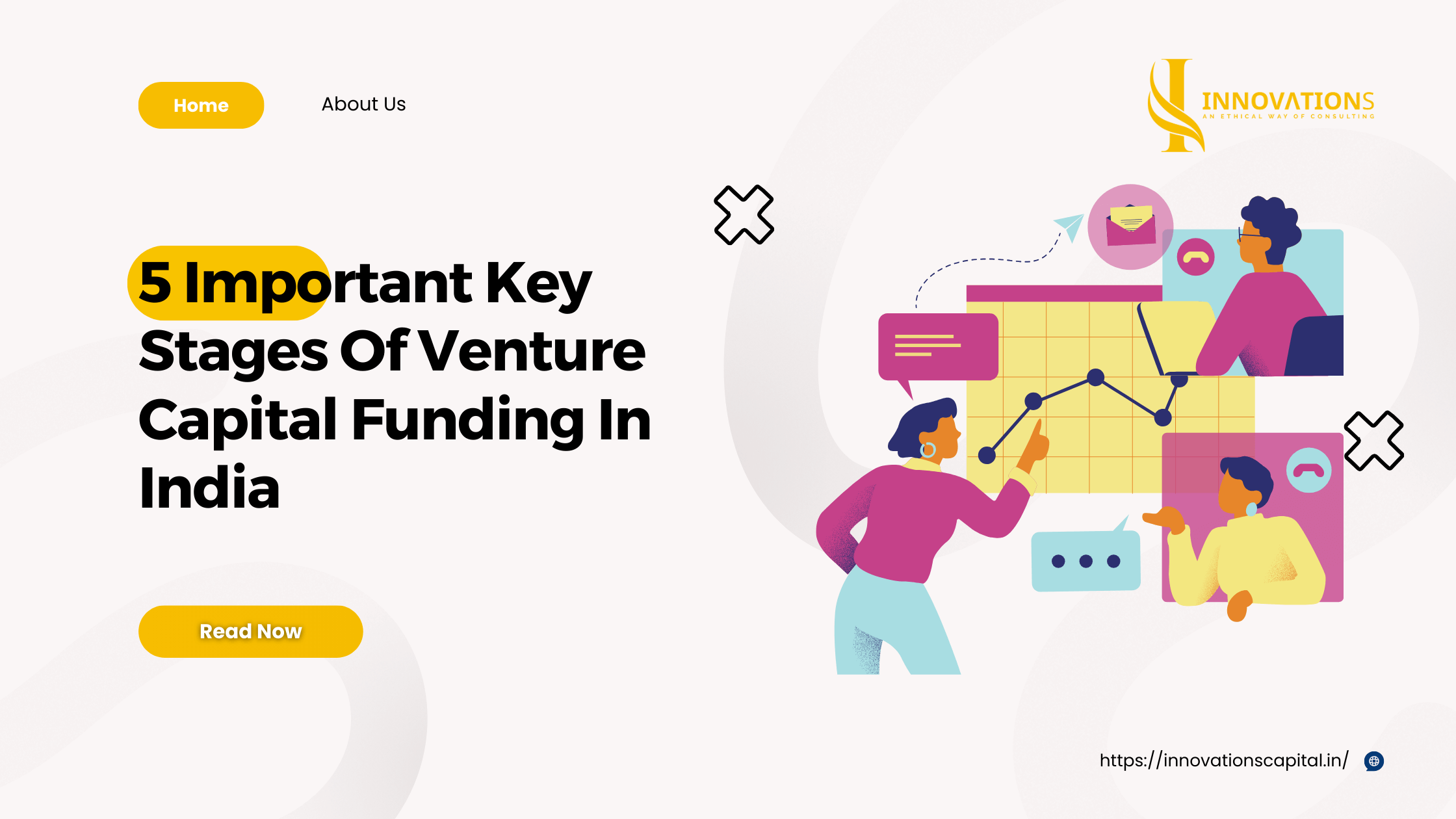Introduction
Venture capital has emerged as a crucial piece of the startup and innovation ecosystem in India. For high-growth startups looking to quickly scale up, venture capital funding is often the preferred route to raise substantial capital. But not all the venture capital is the same. Investors enter at different stages of a startup’s growth journey. Understanding these stages is key for entrepreneurs trying to find the right investors.
Venture capital firms in India provide financing to early-stage companies that show high growth potential. The capital helps startups get their business off the ground, validate their product, hire talent and accelerate expansion. In exchange for the high-risk investment, venture capitalists receive equity stakes in the companies they fund.
For entrepreneurs and founders, being aware of the typical stages of venture capital funding is very important. It helps them target the most suitable investors for their current phase of growth. Approaching the right firms at the right time increases their chances of securing funding on the best terms.
In this blog, we will take a closer look at the 5 important key stages of venture capital funding and the key factors that determine investments at each phase.

What is Venture Capital?
Venture capital refers to financing provided by specialized firms to startups and small businesses that show high growth prospects. It is a form of private equity investment aimed at helping new companies take off and expand.
Venture capital firms raise funds from institutions and high net-worth individuals. They then invest this capital in early-stage companies in exchange for an equity stake. The venture capitalists also often provide expert guidance to the entrepreneur on strategy, operations and high-level networking.
The primary purpose of venture capital financing is to offer funding support to startups that struggle to raise capital from traditional sources like banks and the public markets. These early-stage firms usually have high potential but lack the assets and scale required to obtain conventional financing. Venture capital in India allows such companies to get their business off the ground, validate their product-market fit, scale up operations and drive growth.
The startups that venture capitalists invest in tend to be technology, biotech or other high-growth sector firms that aim to rapidly expand in size and valuation. The business models call for large, upfront investments but have the potential to deliver exponential returns in the long run.

Key Stages of Venture Capital
There are five primary key stages of venture capital financing that startups may go through:
Stage 1: Pre-Seed Funding
Pre-seed funding represents the earliest stage of startup financing. It is meant to provide initial capital for very young companies that are still in the process of formalizing their business idea.
The main objectives of pre-seed funding are to support founders in product development, building a prototype and conducting market validation.
The sources of pre-seed capital include the founders themselves, friends and family, incubators, and pre-seed funds. Some angel investors may also provide capital at this stage.
Startups that are most suitable for pre-seed funding are still at the conceptual stage, likely just a pitch deck and minimal proof of concept. The founders may have quit their regular jobs to focus on the startup full-time.
At this stage, investors evaluate the capabilities of the founding team, their vision and commitment, and the problem being solved. Pre-seed investors take on higher risk but expect founders to use the capital prudently.
Stage 2: Seed Funding
Seed funding represents the first formal round of startup financing from external investors. It aims to support the new company through product development and market launch.
Typical seed funding rounds raise between $500,000 to $2 million. The capital is usually provided by angel investors, seed-stage venture capital firms, and accelerators/incubators.
At this stage, the startup has advanced from conceptualization and prototypes to having an initial product or service ready for launch. There is likely traction in the form of a small customer base.
Seed investors evaluate metrics like product/market fit, traction, early KPIs and the capability of the founding team. Compared to pre-seed capital, seed funding requires more proof of concept and metrics.
The key differences from pre-seed are the larger amounts raised, external investors involved, and more formalization of the business. Founders utilize seed funding to finalize products, expand operations and grow their team.
Stage 3: Series A Funding
Series A funding represents the first institutional round of startup financing from venture capital firms. It aims to help startups scale up effectively after validating their product-market fit and early traction.
Typical Series A rounds raise between $2 million to $15 million. Leading venture capital firms in India provide the financing at this growth stage.
Startups suitable for Series A funding have moved beyond the initial phase and have a strong user base along with good engagement metrics. There is a proven product and business model.
Investors look for rapidly accelerating user growth rates and clear paths to new monetization opportunities. Strong unit economics are also important. Compared to seed funding, the metrics and growth need to be much larger in scale.
The key differences from seed funding are the larger cheque sizes, the focus on scaling over product-market validation, and raising from institutional VC firms rather than angels. Founders utilize Series A capital to expand their teams, fuel user acquisition growth and develop revenue streams.
Stage 4: Series B Funding
Series B funding is the second round of major venture capital fund for startups. Its primary aim is to help companies scale up rapidly and dominate their market.
Typical Series B rounds raise between $10 million to $30 million from VC firms. The capital allows expansion into new markets and user segments.
Startups suitable for Series B have achieved Product-Market Fit, have strong user traction and engagement metrics. Revenues are growing steadily. The key goal is now to diversify into adjacent markets and segments.
Investors evaluate market acceptance, growth strategy, and the startup’s ability to compete with rivals. Metrics like revenue growth, customer lifetime value and churn are analyzed.
Compared to Series A, Series B puts more emphasis on developing repeatable and scalable processes to expand efficiently. Founders use the funds to step up marketing efforts, build operational teams and aggressively acquire customers.
In summary, Series B aims to help startups establish market leadership and scale up the proven model to new demographics and geographies.
Stage 5: Later-Stage Funding (Series C and Beyond)
Later-stage funding refers to advanced rounds like Series C, Series D and beyond. It aims to finance the expansion efforts of more mature startups.
Typical later-stage rounds are $10 million to over $100 million. Large venture capital firms, private equity firms and investment banks provide the high value investments.
Startups suitable for Series C+ funding have established strong product-market fit, have sizeable revenues and growth, and are looking to cement market leadership.
Investors evaluate operating metrics like revenue growth, profitability, customer lifetime value, and churn rates. The ability to outpace rivals is also crucial.
At this mature phase, venture capitalists expect startups to have advanced capabilities in sales, marketing and distribution. Their focus is on rapidly scaling up these functions.
The likely exit strategy for later stage startups is either an acquisition by a large strategic buyer or an initial public offering (IPO). Investors at this point aim to maximize returns from the eventual exit.
In summary, later stage funding helps startups push for IPO-readiness and maximize valuation for an exit.
Challenges and Risks in Venture Capital
While venture capital in India can provide tremendous value to startups, it does come with a unique set of challenges and risks. Being aware of these and taking steps to mitigate them is important.
Some of the key challenges include:
- High failure rate – A large percentage of startups fail to succeed and generate returns. This makes VC a very high-risk asset class. Investors need to diversify and startups should be conservative in cash burn.
- Long feedback loops – Feedback cycles are elongated in scalable startups compared to traditional businesses. This makes pivoting and iteration slower. Startups should focus on agile development and investor communications.
- Inexperienced founders – First-time entrepreneurs often lack experience scaling a business. Mentorship from seasoned VC investors can help here.
- Conflicts of interest – The startup founders’ agenda may differ from the VC firm’s focus on financial returns. Expectation setting and alignment early on is critical.
To address these risks, VCs conduct rigorous due diligence, value investor experience, and maintain constant engagement with their portfolio companies. Entrepreneurs should choose investors carefully and focus on sustainable growth over fast unsustainable expansion.
Overall, while VC comes with risks, the rewards can be significant as well. Maintaining open communications and ensuring proper incentives alignment between investors and founders helps mitigate many challenges. This is where working with the right partner can make all the difference. Innovations Venture Studio helps founders navigate the venture funding process with our extensive experience and founder-friendly approach. We guide startups in identifying compatible investors, negotiating fair terms, and fostering productive ongoing relationships focused on strategic, sustainable growth.
Conclusion
Understanding the different stages of venture capital is crucial for both startups seeking funds and investors looking to back young companies. The objectives, funding amounts, and investor expectations vary significantly across the five main stages – pre-seed, seed, Series A, Series B, and later stage.
For entrepreneurs, being aware of these nuances helps target the most suitable investors at the appropriate phase of growth. This avoids wasted efforts pitching to incompatible VCs. It also sets proper expectations on valuation and the speed of funding.
For investors, specializing in a particular funding stage allows them to add maximum value. Early stage VCs can provide critical mentoring to nascent startups. Growth stage investors help facilitate rapid scaling and expansion for more mature firms.
At Innovations Venture Studios, we partner with startups throughout their venture capital life cycle. Our on-demand digital platform connects high-potential companies to relevant investors, mentors and global opportunities. To help take your startup to the next level, visit https://innovationscapital.in/ today

